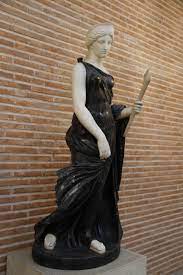The Goddess of Night and Her Dark Children

Welcome back, Greeks and Geeks! With daylight savings just happening this past week, I thought it would be fitting to do a post about Nyx, the Greek Primordial Goddess of Night.
Nyx was one of the children of Chaos. She is the personification of night, and birthed many other personifications of everything related to night. In ancient Greek art, she was depicted as winged, a charioteer, or with a crown of shadow.

She was the only Goddess that Zeus ever feared. When one of her children, Hypnos, God of Sleep, tried to use his powers on him, Zeus was angered and chased him down. When he discovered Hypnos was hiding in Nyx’s cave, Zeus left, and gave up on the chase, all so he would not anger the Goddess.
Despite her being viewed as a sort of evil goddess in Ancient Greek times, she was never more “evil” than Zeus was. But, due to her nature and appearance, many people saw her as an evil goddess.
In mythology, she was never really a centerpiece in any myths. However, Nyx was seen in many important Greek poems. She personified night, and many poets wrote her as the beginning of all things.
She was often worshipped in the background of other Gods or Goddess, most notably Artemis, the Goddess of the Moon and the Hunt.
Nyx had many children: Aether, the God and personification of the “upper sky,” or the air that the Gods breathe (as opposed to the regular air reserved for us mortals), also referred to as the God of light; Hemera, Goddess and personification of daytime; Moros, God and personification of impending doom; Apate, Goddess and personification of deceit; Dolos, the spirit of trickery and guile; Nemesis, Goddess of revenge; the Keres, the Goddesses and personification of violent death (they are also referred to as death-spirits); the Moirai, or the Fates, the incarnations of destiny; the Hesperides, the nymphs of evening and the golden light of sunlight; Oizys, the goddess of misery, anxiety, grief and depression; Momus, the God and personification of satire and mockery; the Oneiroi, the personifications of dreams; Hypnos, the God of sleep, Thanatos, God of death; Philotes, the Goddess and personification of affection, friendship, and sex; Geras, the God of old age; Eris, Goddess of strife; and Charon, the ferryman of Hades, who leads souls into the Underworld.
Her children appear in more myths than she does.

In one story, her son Thanatos was captured and chained by a mortal king called Sisyphus. When Thanatos was chained, he was unable to collect any newly deceased spirits, so nothing was dying. Ares, God of War, discovered this during a battle in which no one was dying. Ares freed Thanatos, then brought Sisyphus down to the Underworld himself.
In another, her daughter Eris created the Apple of Discord, which led to the Trojan War (a story for another time).
Charon was another important child of hers. He guided souls to Hades, so he was important in many funeral rites. During the funeral, one had to be put to rest with a coin in their mouth, under their tongue. This was called “Charon’s Obol.” If they did not have a coin to give to Charon, they were forced to wander the Earth for 100 years until they were allowed passage.
With the coins, Charon leaves them in the Underworld with Hades. But, once the stack of coins reaches the top of the Underworld, it is said that the dead will break free and the world will end. (Let’s hope that doesn’t happen anytime soon! 2020 was enough horror.)
Nyx and her children are among my favorite Greek deities, despite how little of them are told in mythology. Though many of them are the personification of bad things, or perceived bad things, I find them very interesting to read about.
Coming up in a few days is the Spring Equinox, so come back soon to read the story of Persephone and Hades, as they say good-bye and Persephone comes to the overworld to bring Spring to us all (finally).
Thank you, as always, for reading, and I hope to see you soon. Αντίο, Σοφία.



